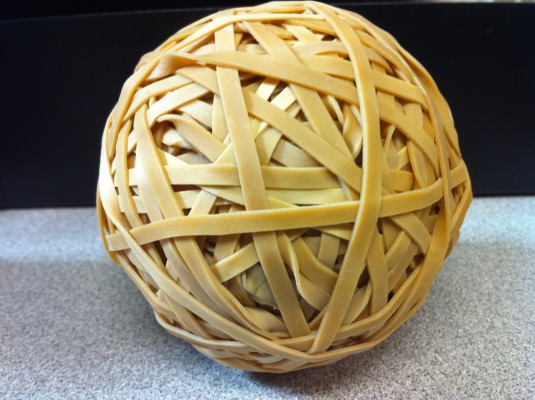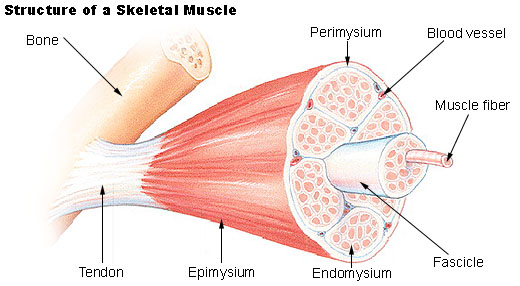
Teachers often use the image of a rubber band to describe muscles. When you stretch a rubber band, it usually returns to its normal size; if you continuously pull it beyond the maximum that it can be stretched, the rubber band stays stretched out. Using this metaphor, if you continuously stretch your muscles beyond their maximum range of motion (ROM), eventually they will stay stretched out…..
Sort of.
Muscles have two main jobs: generating power and responding to “perturbations”.
The rubber band/muscle metaphor is great in describing the body’s response to perturbations (such as the bus moving forward when you’re not ready for it, someone handing you something that you think is heavy but is actually light, being bumped into, etc). In these instances, a reaction called the stretch reflex recoils muscles that have been stretched as a result of a perturbation. In the example of standing on a bus that moves when you’re not expecting it, you’ll notice that you lean forward and then right yourself. If the muscle is stretched too far, the muscle can’t recoil and instead you are forced to take a step forward to prevent from falling.
Try this: Stand up with your feet under your hips and eyes closed. You’ll notice that you sway forward and back slightly. In order to help you maintain balance, your brain triggers muscle action in the calf and ankle when you start to pitch forward, righting your stance . This is the stretch reflex in action (in combination with structures in the inner ear that control balance).
While the image of a rubber band is useful in demonstrating the elastic nature of muscles in the stretch reflex, it’s not always as simple as the stretch/recoil and stretch-farther/less-recoil that we gain from thinking of muscles simply as rubber bands.
I’ll explain, but first, a brief anatomy and physiology lesson:
How do muscles work?
A muscle is built of bundles of lots and lots and lots of muscle fibers bundled together by a sheath called the sarcolemma. One muscle fiber contains lots and lots and lots of myofibrils, and one myofibril contains two types of myofilaments (thick and thin). This is where the magic happens.
The brain sends a signal (a neural impulse called an action potential) to the muscle that says “Hey muscle! Contract!” Through a complex series of chemical reactions, proteins on the thick and thin filaments bond to one another and create energy in a chemical form. The chemical energy is converted into a mechanical (tensile) force that generates power to move bone. Every time you point, jump, bend, etc. your body goes through the same brain-muscle-bone loop called Excitation-Contraction Coupling (in case you want to look it up on Wikipedia) and it all happens faster than you can snap your fingers.
Wow. That’s amazing. And not at all like a rubber band.
Apart from this complex process, there are a number of variables that impact muscle behavior, such as temperature. Warming-up increases the body’s core temperature and also helps breaks any leftover bonds (what I refer to as “crunchiness”) that might be hanging around. As mentioned in my previous post, Is It Okay To Stretch Before Class?, stretching before activity has a short-lasting (acute) effect on range of motion, but the effect of stretching is maximized if you are warmed-up. Warming up also increases the amount of power a muscle can produce, making movements more efficient.
Think about this: What would it feel like to do grand allegro first in a ballet class? I don’t care to find out, but you can imagine that your ability to produce power, and therefore height, in your jumps is much better at the end of class when your muscles are warm. Muscles also react differently when they are sore, strained or fatigued and all of these topics are complicated enough to deserve their own posts, so I won’t delve into them here…
More than anything else, I want to emphasize that rubber bands don’t have brains. The key point in all of this is that you have a brain, and that your brain drives everything that happens in your muscles. It senses unexpected events and recoils muscles back into place. It sends neurological impulses to muscles, causing a series of chemical reactions, producing energy that is converted into force that makes you move. I said it once, and I’ll say it again:
That is amazing.
Reference: Enoka, R. M. Neuromechanics of Human Movement, 3rd. edition
Lauren Warnecke is a freelance writer and editor, focused on dance and cultural criticism in Chicago and across the Midwest. Lauren is the dance critic for the Chicago Tribune, editor of See Chicago Dance, and founder/editor of Art Intercepts, with bylines in Chicago Magazine, Milwaukee Magazine, St. Louis Magazine and Dance Media publications, among others. Holding degrees in dance and kinesiology, Lauren is an instructor of dance and exercise science at Loyola University Chicago. Read Lauren’s posts.



